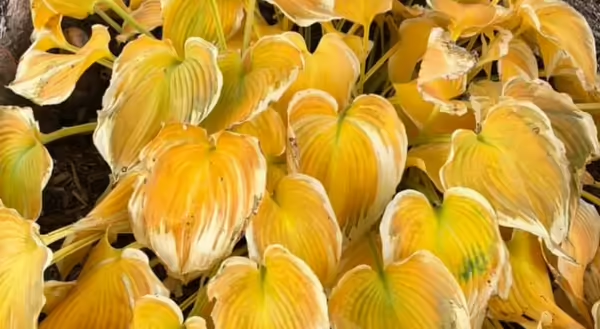
Hostas are among some of the most cherished perennials of all time, creating a lush pallet of bright greens, muted greens, chartreuse greens, variegated greens and creams, and blue greens. This fall, some are displaying a vibrant yellow lighting up the landscape.
They come in miniature versions to lofting leaves as tall as a small child. Hostas are commonly described as ''fabulous foliage plants" by the industry, but some of their blooms can be exceedingly showy, exceptionally fragrant, and especially attractive to hummingbirds and bees.
These perennials thrive planted in the shade of trees and are acknowledged for their reliability and hardiness. Spreading by rhizomes, they can be easily divided in the early spring by digging up and separating growing tips.
Winter hosta care
Many hosta gardeners may not realize this, but there are a few winter garden tasks that will help maximize their display:
- Cut foliage. Once fall color subsides, cut back your hosta foliage and petioles. If hosta nematodes are present, they can be removed before settling back in the crown, plant debris, or soil. Hosta nematodes are microscopic roundworms that live and feed on the hosta leaves. Symptoms show up in the early summer as yellow discoloration followed by brown streaking between the veins, eventually killing the older leaves. If a disease is present, dispose of discarded spent foliage so that it does not spread the following spring. Hosta disease comes in a wide range of leaf markings. Cutting back the foliage also reduces future slug populations.
- Add organic matter. Hostas prefer rich soils high in organic matter. Adding organic materials such as peat, composted manure, kitchen compost, or shredded leaves will help improve soil structure and add nutrients. Add handfuls into the soil when cutting back leaves.
- Trim wet leaves. Remove soggy wet leaves tree leaves from the hosta crown to discourage slugs, rabbits, and voles.
- Add insulation: If hostas are newly transplanted, a layer of mulch may be added after the ground has frozen. This will insulate the soils to prevent frost heaving. Remember to remove the mulch the following spring so the crown does not rot.
- Prepare for pests: Vole damage on hostas may have to be addressed through garden alterations, repellents, and trapping.
PHOTO CREDIT: Hosta in Fall, University of Illinois Extension
ABOUT THE AUTHOR: Kelly Allsup is a former Horticulture Educator for University of Illinois Extension serving Livingston, McLean, and Woodford Counties.